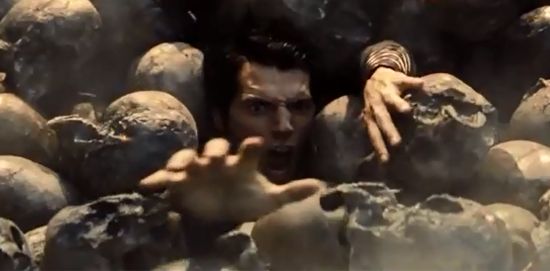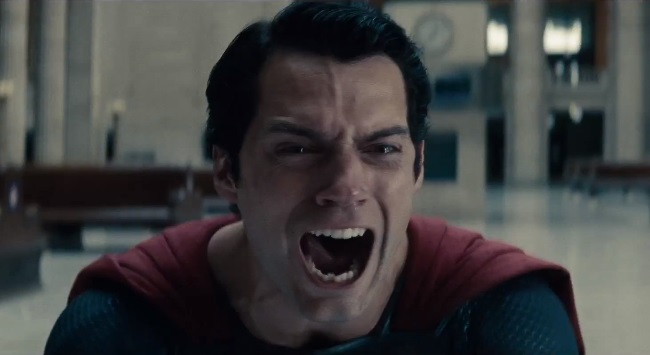Home » Posts tagged 'Kypton'
Tag Archives: Kypton
Man of Steel – SPOILER WARNING
July 15, 2013 1:16 pm / 5 Comments on Man of Steel – SPOILER WARNING
 I recently posted on my top five of the year so far, and placed Man of Steel at number 4. This puts it ahead of Oblivion, After Earth, Iron Man Three and Star Trek Into Darkness as the finest blockbuster I’ve seen in 2013, a film I would describe as swell, and it is a film that swells. This might be a controversial choice, as Man of Steel has been met with very mixed reviews, some disappointed over its treatment of beloved comic book elements (which always happens with adaptations), others complaining that it is too dour and not enough fun, and the standard criticism of blockbusters that plot and character get left behind in the midst of all the destruction and special effects.
I recently posted on my top five of the year so far, and placed Man of Steel at number 4. This puts it ahead of Oblivion, After Earth, Iron Man Three and Star Trek Into Darkness as the finest blockbuster I’ve seen in 2013, a film I would describe as swell, and it is a film that swells. This might be a controversial choice, as Man of Steel has been met with very mixed reviews, some disappointed over its treatment of beloved comic book elements (which always happens with adaptations), others complaining that it is too dour and not enough fun, and the standard criticism of blockbusters that plot and character get left behind in the midst of all the destruction and special effects.
For me though, Man of Steel provided everything I want from a blockbuster and a superhero movie. There are others later this year, including The Wolverine and Thor: The Dark World, but the standard set by Man of Steel (as well as Iron Man Three) is pretty high. I have never been as big a fan of Superman as I am of Batman and Spider-Man, because Superman can be too powerful to be relatable – if he is invulnerable, there is no drama. Man of Steel avoids this pitfall of the character, making Kal vulnerable, relatable and human. At the same time, director Zack Snyder delivers enthralling and enveloping action sequences that allow the viewer to experience the thrills and pains of super powers, which is a key ingredient in the superhero genre.
Movie of Swells
The trope of swelling recurs throughout Man of Steel, apparent from the very beginning as Lara Lor-Van (Ayelet Zurer) gives birth, her screaming and panting swelling along with the music. As we subsequently learn, Kal is the first Kyptonian to have been born this way in generations, so his very existence is a swelling of resistance. Rebellion swells across the opening sequence on Krypton, as Jor El (Russell Crowe) faces the senior council and urges evacuation as the planet itself swells with tectonic forces. The swelling menace erupts as General Zod (Michael Shannon) attempts a coup, and the sequence culminates with the explosion of Krypton.
Swelling continues as the adult Clark Kent (Henry Cavill) travels north in search of answers, and his memories demonstrate his swelling confusion and inner turmoil. Man of Steel’s flashbacks echo Batman Begins, with the young adult developing his hero persona through current events, like saving men aboard a burning oil rig, and those from his childhood, such as lifting a school bus out of a river. Finally, when Clark reaches a crashed Kryptonian scoutship and learns the truth of who he is, the swelling of his potential continues through a montage, once again reminiscent of writer/producer Christopher Nolan’s Batman trilogy. The suit that Kal El will wear, the history of Krypton, the philosophy that Jor delivers to him, are all intercut with Kal striding out of the ship, cape billowing behind him, until he stands in the sun and crouches, ready to take flight. His first flight comes one hour into the film (just like “I’m Batman!”), which has been swelling towards this point. When I saw Kal ascend, less like a speeding bullet and more reminiscent of a bolt of light, the hairs rose on my arms as I felt myself vicariously hurtling up with him. The greatest moments in movies are often those that transport us, and for that moment, I felt myself transported with him.
 Not that the first flight goes too well, as Kal crashes into a mountain and takes some time getting used to his abilities. This is one of Man of Steel’s great strengths, showing the confusing effect of superpowers as well as their glory. Superpowers are often presented as exhilarating, such as Peter Parker’s discovery of his ability to climb walls and jump great distances in both Spider-Man and The Amazing Spider-Man. Powers can also be presented as dangerous, as in the emergence of Jimmy Logan’s bone claws in X-Men Origins: Wolverine and Rogue’s ability to suck energy in X-Men, or the first emergence of the Hulk in both Hulk and The Incredible Hulk. But these are presented as dangerous to the viewer, in the position of a bystander. In Man of Steel the frightening element of superpowers is presented from the perspective of the super being himself. An impressive instance of this appears in an early flashback, as Clark becomes disorientated and scared at school because he can see and hear too much. The scene begins with extreme close-ups of pencils, the edges of desks and other classroom clutter, culminating in his teacher and classmates appearing as moving skeletons. This visual and aural cacophony overwhelms the viewer much as it does Clark, who hides in a closet until his mother Martha (Diane Lane) can talk him out, soothing him with the recommendation to make the frighteningly large world smaller. He may have super powers, but they are no protection against fear.
Not that the first flight goes too well, as Kal crashes into a mountain and takes some time getting used to his abilities. This is one of Man of Steel’s great strengths, showing the confusing effect of superpowers as well as their glory. Superpowers are often presented as exhilarating, such as Peter Parker’s discovery of his ability to climb walls and jump great distances in both Spider-Man and The Amazing Spider-Man. Powers can also be presented as dangerous, as in the emergence of Jimmy Logan’s bone claws in X-Men Origins: Wolverine and Rogue’s ability to suck energy in X-Men, or the first emergence of the Hulk in both Hulk and The Incredible Hulk. But these are presented as dangerous to the viewer, in the position of a bystander. In Man of Steel the frightening element of superpowers is presented from the perspective of the super being himself. An impressive instance of this appears in an early flashback, as Clark becomes disorientated and scared at school because he can see and hear too much. The scene begins with extreme close-ups of pencils, the edges of desks and other classroom clutter, culminating in his teacher and classmates appearing as moving skeletons. This visual and aural cacophony overwhelms the viewer much as it does Clark, who hides in a closet until his mother Martha (Diane Lane) can talk him out, soothing him with the recommendation to make the frighteningly large world smaller. He may have super powers, but they are no protection against fear.
Powers
Man of Steel works for me because it conveys consistently and convincingly the experience of super powers. As Kal grows in confidence, so do we follow his progress. Subsequent scenes of flight are both beautiful and compelling – the tagline for the original Superman: The Movie was “You’ll believe a man can fly”. Man of Steel, oddly, has no tagline, but it could easily be “You’ll believe a man can fly, and you with him”. Not only fly, but fight, as the final act, when Kal battles the forces of Zod, yanks the viewer right into the action. This sequence has been a major target for criticism, described as nothing but mindless action in the vein of Transformers, rendered in such a way that you cannot see what is going on, and with insufficient attention paid to the inevitable death toll of such extensive destruction.
I did not have these problems, as not only could I see everything that was going on, I also felt it, the kinetic force of Snyder’s camera, not to mention the cacophonic soundtrack, had me sharing every swoop, collision and explosion. As mentioned above, a key ingredient for me in a successful superhero film is the cinematic expression of superpowers, and Man of Steel delivers both on the intimate scale in the flashbacks, and the epic grandeur of the almighty Kryptonian smackdown. In addition, the stakes of this climactic battle are abundantly clear, as Zod’s mission is to preserve the Kryptonian race, to the extent of terra-forming Earth into a new Krypton. The impact of this mission is illustrated in a dream Kal shares with Zod, in which Earth is re-shaped and Kal sinks into a pile of skulls, this grim horror serving as perfect motivation for the climax.
Man of Steel is not without problems. Shaky cam in the opening sequence is an unfortunate distraction because Krypton is a glorious creation that cannot be fully enjoyed. Also, while the climax is spectacular, it takes too long to get going, initial skirmishes between Kal and Zod’s forces proving to be false starts that become tiresome as they are clearly preludes. That said, these skirmishes do continue the film’s interest in power as disorientating, as Zod and his troops also have to adjust to seeing through their own hands. The alien element of Man of Steel is well-handled, but the early scraps fail to add drama, although it is effective to see Kal getting his ass kicked by trained soldiers.
Once the final battle really kicks off though, it is as spectacular as anything I’ve seen in a cinema this year, rising above Iron Man Three and Star Trek Into Darkness to name a couple (although at the time of writing I am yet to see Pacific Rim). Kal’s desperate attempt to save Lois Lane (Amy Adams), his struggle to destroy the world engine and his eventual return of the Kryptonian ship to the Phantom Zone are all enveloping action sequences, the slightly grainy film quality and detail of the production design and effects creating an absorbing and enthralling cinematic experience.
Best of all is the final clash between Kal and Zod, as Zod fully embraces the power that Earth’s sun imbues him with, mocking Kal with his warrior background while ‘Superman’ was raised on a farm. A true clash of the titans, Kal and Zod’s titanic duel is literally out of this world, as the two hurl each other out of the atmosphere and collide with satellites (amusingly branded as Wayne Enterprises, perhaps foreshadowing a Justice League movie). But the culmination of their clash is a perfect encapsulation of inner and outer conflict, as Kal must kill Zod in order to save innocent bystanders. I had a debate over the importance of this killing, as it seems did the director, writer and producer. For Superman to kill was shocking, as I had never seen that before. Apparently there are comic book stories in which he has killed, but these are outside the accepted canon. Either way, that moment in Man of Steel was superb because it was genuinely shocking. I’ve barely read a Superman comic book, but the film and TV versions I have seen emphasise Superman’s moral compass and restraint. Therefore, seeing him kill someone was a huge surprise and clearly a massive emotional blow, demonstrated by his scream of anguish and collapse into Lois’ arms. We now know how far Kal-El can go, and to have him traumatised makes him all the more interesting.
Trauma
It is probably no coincidence that the superhero genre has been so embraced in the aftermath of 9/11, and much like Spider-Man, The Dark Knight and The Avengers, the shadow of the infamous terrorist attacks hang over Man of Steel. The devastation of Metropolis is reminiscent of images of New York from 9/11, as buildings collapse and debris falls from the sky. Some have criticised the sanitisation of this destruction – surely thousands of people must have been killed – and while this is valid I think the criticism misses the point. In a crucial moment, Jenny Olsen (Rebecca Buller) is trapped under debris, and Perry White (Laurence Fishburne) and Steve Lombard (Michael Kelly) struggle to free her. They are themselves in danger, and indeed they would all have died had Kal not arrived in the nick of time, but the moments of Perry and Steve doing what they can to try and free Jenny is a wonderful illustration of ordinary heroism. Perhaps they have been inspired by Kal’s example, willing to surrender himself to Zod’s forces, or they were already brave and selfless, but whatever their motivation, it is a powerful moment, mixing the terror of the attack with a positive vision of humanity. It is post-9/11 romantic wish-fulfilment, to have a superman come to the rescue, and I find it satisfying because of the recognition and catharsis stimulated by this fulfilment.
I recently had a long debate over what superheroes are ‘doing’, beyond blowing stuff up and acquiring/achieving. I found the argument rather odd, because saving the world, in style, blowing stuff up and taking us along for the ride seems exactly what superheroes are there for. My fellow debater was being unfairly judgemental, I thought, as they seemed to have a sense that superheroes should do something more, but it was unclear exactly what that more would be. In the case of Man of Steel, I think the film is doing exactly what Jor El tells his son – that he will give the people of Earth something to aspire to. Superpowers are not necessarily a blessing, and they are not a prerequisite for doing good and helping others. The young Clark may have the strength to lift buses out of rivers, but one of the boys Clark saves offers his hand to help Clark up when bullies have knocked him down, but he has not struck back at them. Jonathan Kent (Kevin Costner) sacrifices his own life to save others, including telling Clark not to use his powers to save him. Perry and Steve must use their own strength and resourcefulness to try and save Jenny, and Lois proves her mettle in Zod’s ship with timely advice from Jor. Repeatedly in Man of Steel, heroism is shown to be a choice, not a destiny, and a choice that we can all make. Perhaps, in time, we can all join Kal El in the sun.



